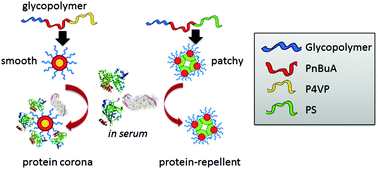Surface roughness influences the protein corona formation of glycosylated nanoparticles and alter their cellular uptake†
Abstract
Recently the role of protein absorption in nanoparticle drug delivery has gathered significant attention as the protein corona can significantly decide on the fate of nanoparticles in the body. Although it is known that the surface chemistry will significantly influence the amount and type of bound protein, there is little known about the effect of surface roughness and surface topography on the interaction. In this work, we show how patchy nanoparticles can noticeably reduce the adsorption of proteins compared to spherical nanoparticles with a smooth surface as demonstrated using six ABC triblock terpolymers based on glucose, mannose and galactose. To obtain patchy nanoparticles, poly(2-D-sugar ethyl acrylate)-b-poly (n-butyl acrylate)-b-poly(4-vinyl pyridine) (PSugEA-b-PBuA-b-P4VP) was prepared by reversible addition–fragmentation chain-transfer (RAFT) polymerization and assembled into nanoparticles with a patch-like appearance and a hydrodynamic diameter of around 130–160 nm. As control, smooth nanoparticles were prepared from poly(2-D-sugar ethyl acrylate)-b-poly (n-butyl acrylate)-b-polystyrene (PSugEA-b-PBuA-b-PS). The patchy nanoparticles displayed significantly reduced protein absorption when exposed to serum-supplemented cell culture media, as observed using dynamic light scattering. The smooth particles, however, supported the formation of a large protein corona. Additionally, an enrichment of haemoglobin was observed in the corona compared to the serum protein in solution. The amount of albumin on the surface was observed to be dependent on the type of sugar with glucose resulting in the highest absorption. The protein corona led to cellular uptake that was unrelated to the underlying sugar, which was supposed to help targeting specific cell lines. This example demonstrated how the protein corona can override any attempts to target receptor expressing cells.



 Please wait while we load your content...
Please wait while we load your content...